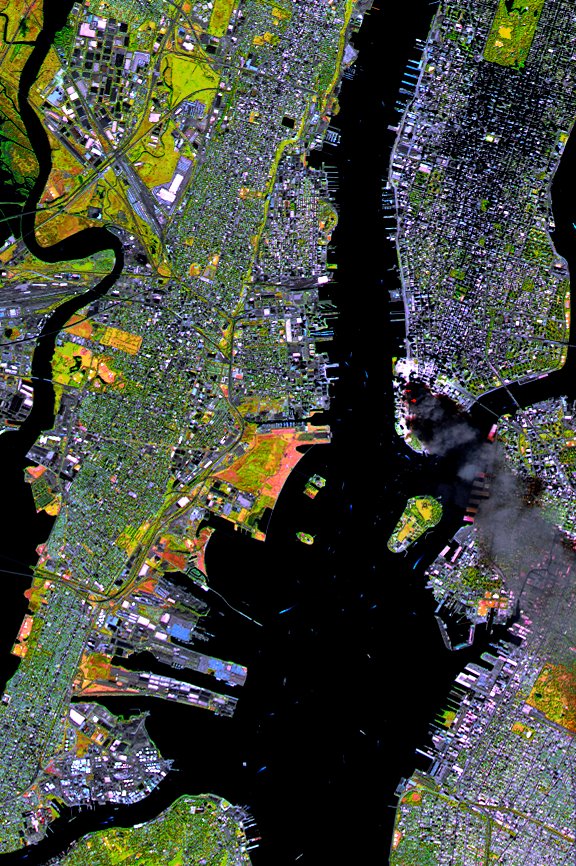
As the 10th anniversary of the September 11 terrorist attacks approaches, NASA is stressing the role that cooperative space exploration can play in making the world a better place.
Projects such as the International Space Station help blur the differences that can pit nations and peoples against each other, highlighting instead what humanity can accomplish when it works together, NASA officials said.
"We will never forget 9/11, but we are nevertheless optimistic about the future," NASA administrator Charlie Bolden said in a statement Friday (Sept. 9). "It is a bright future for the kind of cooperative exploration that will inspire humanity and lift our thoughts to the higher potential of which we are capable." [9/11 Remembered in Space Photos]
Lessons of 9/11
The United States had one citizen off-planet on Sept. 11, 2001 — NASA astronaut Frank Culbertson, who was commanding the International Space Station at the time.
Culbertson had a bird's-eye view as the terror attacks on New York City's World Trade Center went down.
"I didn't know exactly what was happening, but I knew it was really bad, because there was a big cloud of debris covering Manhattan," Culbertson recalled in a NASA video marking the 9/11 anniversary. "It was like seeing a wound in the side of your country, of your family, your friends."
Get the Space.com Newsletter
Breaking space news, the latest updates on rocket launches, skywatching events and more!
The attacks had a profound influence on Culbertson, and he said it's vital that the nation and the world continue to learn lessons from that fateful day. A veteran of the war in Afghanistan who was impressed that Culbertson had commanded the space station stressed one such lesson to the astronaut when the two men met.
"The first thing he said to me was, 'That's one of the best things we're doing. We have to work together internationally, or we'll never solve all these problems,'" Culbertson said.
Bolden voiced similar sentiments, emphasizing the bridge-building potential of the space station and other cooperative space efforts.
"Frank Culbertson returned to a different world than that from which he launched," Bolden said. "But all of the space station's international crews have demonstrated how space exploration can bring our world together, erase borders and improve the lives of people across the world."
NASA commemorates 9/11
NASA scientists and satellites were called into action in the aftermath of the 9/11 attacks, helping search for aerial contaminants near Ground Zero and monitoring the unfolding situation from above.
Over the years, the agency has also marked the tragedy and honored its victims in various ways. For example, astronauts aboard the space station have radioed tributes down to Earth, beginning on 9/11 itself and continuing to the present day. [Related: NASA 9/11 Tributes Reach Out to Mars & Back]
And the space shuttle Endeavour carried nearly 6,000 miniature American flags on its STS-108 mission to the orbiting lab in December 2001 — the first shuttle flight after 9/11. After the flags came back down to Earth, they were distributed to relatives of the terror strike's victims.
Further, NASA sent pieces of metal from the fallen Twin Towers to Mars. The New York-based company Honeybee Robotics, which helped build the twin Mars rovers Spirit and Opportunity, fashioned small pieces of aluminum from Ground Zero into dust covers for the rovers' rock abrasion tools.
Spirit and Opportunity landed on the Red Planet in January 2004. Spirit stopped communicating with Earth in March 2010, but Opportunity is still going strong.
You can follow SPACE.com senior writer Mike Wall on Twitter: @michaeldwall. Follow SPACE.com for the latest in space science and exploration news on Twitter @Spacedotcom and on Facebook.
Join our Space Forums to keep talking space on the latest missions, night sky and more! And if you have a news tip, correction or comment, let us know at: community@space.com.

Michael Wall is a Senior Space Writer with Space.com and joined the team in 2010. He primarily covers exoplanets, spaceflight and military space, but has been known to dabble in the space art beat. His book about the search for alien life, "Out There," was published on Nov. 13, 2018. Before becoming a science writer, Michael worked as a herpetologist and wildlife biologist. He has a Ph.D. in evolutionary biology from the University of Sydney, Australia, a bachelor's degree from the University of Arizona, and a graduate certificate in science writing from the University of California, Santa Cruz. To find out what his latest project is, you can follow Michael on Twitter.









